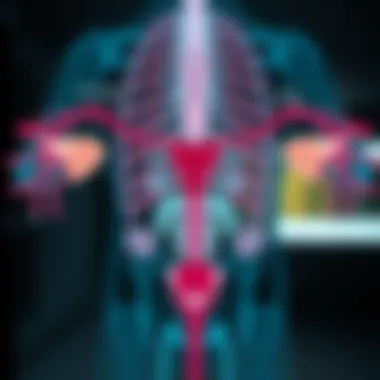Understanding Post-Abortion Cramping Duration and Effects


Intro
When it comes to the experience following an abortion, one aspect that often raises questions and concerns is the duration and nature of cramping. This phenomenon can be quite unsettling for many, leading them to wonder about the underlying reasons and when to seek help. It’s vital to understand that post-abortion cramping is a common and normal symptom. However, the intensity and length can vary significantly among individuals. Some, for instance, might find themselves dealing with mild discomfort, while others may experience more severe sensations.
Inputting an understanding of physiological and psychological factors involved in this issue can shed light on why the experience is so diverse. By delving into these different facets, we can help provide context, reassurance, and a clearer roadmap for those navigating the recovery path.
Research Context
Background Information
Cramping following an abortion can largely be attributed to the body's natural response to the procedure. The uterus, having gone through significant changes, undergoes contractions similar to menstrual cramps. Generally, these contractions help the uterus return to its pre-pregnancy state. Studies suggest that the intensity and duration of cramping can be influenced by numerous factors, including the hormone levels, method of abortion, and individual pain thresholds. For instance, those who underwent a surgical abortion through procedures like aspiration may face cramping that feels different compared to those who opted for medical abortion.
Importance of the Study
Understanding the duration and implication of cramping is essential for several reasons. First, it arms patients with knowledge that can ease anxiety; understanding what constitutes a normal recovery process can make a world of difference. Moreover, health professionals can benefit from this knowledge, ensuring they provide informed support and guidance to their patients. Medical practitioners also need to be aware of varying symptoms to identify potential complications that may need intervention. Thus, this discussion serves an important role in bridging gaps in knowledge within both patient and provider circles.
Discussion
Interpretation of Results
Research indicates that on average, individuals may experience cramping for several days following an abortion. Some report that the discomfort lingers for about three to five days, but more acute pain can occur depending on specific circumstances. This variance is due to factors like hormonal changes, the method of abortion, and personal emotional responses during the process.
The psychological factors at play can also not be overlooked. Many individuals may feel stress or worry surrounding their recovery, which can amplify the perception of cramping. This emotional arousal in turn can lead to a cycle where physical discomfort feels heightened. Addressing emotional well-being through support networks and counseling can be equally as important as treating physical symptoms.
Comparison with Previous Research
When compared to past studies, the observed duration of cramping tends to align with existing literature. Earlier research consistently notes that while cramping is a typical post-abortion symptom, its duration varies largely among individuals.
Interestingly, factors such as preexisting medical conditions or prior experiences with menstruation can add layers of complexity to each person’s response. For example, those with a history of dysmenorrhea, or painful periods, might perceive cramping following an abortion differently than those without such a history.
In summary, understanding the duration and implications of cramping post-abortion allows for a more informed perspective on the healing process. By recognizing both the physical and emotional dimensions of this experience, individuals can better navigate their recovery with reassurance and clarity.
"Knowledge is power, and understanding the typical recovery process can greatly reduce anxiety for those facing this journey."
For further insight, you can explore resources like NHS, Planned Parenthood, and related discussions on platforms like Reddit.
Understanding Cramping After Abortion
Understanding cramping after abortion is critical for anyone navigating the aftermath of this significant health procedure. Cramping is often the body’s natural reaction to physiological changes, and recognizing its implications can pave the way for better management and healing. By delving deeper into this topic, individuals can demystify their experiences, equipping them with the knowledge necessary to differentiate between typical and atypical symptoms.
The importance of acknowledging cramping lies in its dual impact—physiological and psychological. Physical discomfort can significantly influence a person's emotional state, exacerbating feelings of anxiety or stress. This highlights the need for comprehensive knowledge on the duration and nature of cramping. Understanding these nuances serves as a guide, ensuring that individuals recognize when discomfort might signal the need for professional assistance, or when it falls within the realm of normal recovery.
A primary focus should be on what causes cramping post-abortion. This knowledge not only addresses the immediate concerns but also instills a sense of empowerment in those experiencing it. Informed readers can approach the recovery process with a clear perspective, making it easier to manage both physical sensations and emotional responses.
Lastly, fostering awareness about various physiological responses can influence healthcare practices. For educators and professionals in reproductive health, this understanding can translate into better support networks for individuals, aiding in the reduction of stigma associated with abortion recovery. Therefore, the discussion of cramping transcends mere symptomatology; it touches on the essence of informed care and compassionate support during a vulnerable time.
What Causes Cramping Post-Abortion?
Cramping post-abortion can be attributed to several factors, primarily linked to the body's mechanism of expelling the contents of the uterus. The process involves uterine contractions, which can manifest as cramping. These contractions can vary in intensity and duration, depending on the method of abortion performed—be it medical or surgical.
Understanding these causes can greatly ease the anxiety often associated with cramping:
- Uterine Contraction: After abortion, the uterus contracts to ensure it returns to its pre-pregnancy size.
- Hormonal Changes: The hormonal shift following an abortion can cause discomfort, including cramping.
- Physical Trauma: Any surgical intervention may lead to temporary irritation or injury to the surrounding tissues.
Individuals should be aware that these cramps are usually not dangerous. However, recognizing the potential for atypical symptoms involves knowing what is happening internally.
Physiological Responses to Abortion
Physiological responses following abortion can be a mixed bag. Each person’s body reacts differently based on a variety of factors, including overall health, the stage of pregnancy, and individual pain tolerance.
- Variability: It's essential to understand that reactions can vary greatly; some may experience mild cramping while others could face more intense discomfort.
- Duration: Typically, cramping can last from a few hours up to several days, although some individuals report longer periods of discomfort.
- Accompanying Symptoms: Other physiological responses may include mild bleeding, mood fluctuations, or gastrointestinal distress, which can complicate the experience and intensify distress.


Moreover, engaging with these bodily responses can eliminate feelings of isolation or confusion during recovery. It’s critical for individuals to seek out reliable information and community resources to navigate these changes effectively. Recognizing what is normal in terms of physiological response post-abortion not only helps to ease concerns but also fosters a more supportive environment for recovery.
Duration of Cramping: Typical Timelines
Understanding the duration of cramping following an abortion is crucial for various reasons, particularly for those who are navigating the physically and emotionally taxing process. It is not just about knowing how long the discomfort will last; it is also about setting realistic expectations and recognizing when to reach out for help. Those experiencing cramping can benefit significantly from a comprehensive understanding, as this knowledge can lead to better coping strategies and informed discussions with healthcare professionals.
Typically, cramping is a natural physiological response as the body heals. However, the variation in experiences can be wide, which adds to the importance of awareness regarding typical timelines and patterns. Sometimes cramping can be brief and mild, while for others, it may extend into a prolonged experience. Knowing the lengths of cramping can help in identifying whether what is being felt is within the norm or calls for medical attention.
Immediate Cramping After the Procedure
After undergoing an abortion, many individuals report cramping right away. This is generally a sign that the uterus is contracting, facilitating the expulsion of tissue.
- Timelines: Such immediate cramping can occur within minutes to hours after the procedure.
- Intensity: It may range from mild to moderate intensity, often akin to menstrual cramps.
- Duration: This phase typically lasts a few hours, but can be exacerbated by factors like anxiety or underlying health conditions.
However, it’s vital to pay attention to the severity. If the cramping becomes unbearable or is accompanied by heavy bleeding, it’s advisable to seek assistance from healthcare providers.
Short-Term Cramping Symptoms
In the days following an abortion, cramping is often expected to persist, although it usually lessens in intensity.
- Timeline: Generally, this short-term cramping can last from a few days up to two weeks.
- Variability: Some may experience sporadic cramps that come and go, while others may feel consistent discomfort.
- Coping Methods: Using heat packs, staying hydrated, and practicing relaxation techniques might help in managing this phase.
It’s important to be mindful though; if the cramping seems to worsen rather than improve, it could be a sign of complications that require medical evaluation.
Long-Term Cramping: When to Be Concerned
Long-term cramping, defined as discomfort persisting beyond two weeks, can indicate a potential issue.
- Typical Signs of Concern: Symptoms might include excessive pain, fever, or unusual discharge, which could suggest infections or other complications.
- Consultation: At this point, pursuing medical advice is strongly recommended. Monitoring the nature of cramping closely will arm individuals with the information needed for an informed discussion with their healthcare provider.
Always listen to your body and trust your instincts; if something feels off, it may be worth checking in with a professional.
Keeping track of the duration and characteristics of cramping offers not just peace of mind but also can play a crucial role in the healing process post-abortion. Accountability to one's body during this time can lead to a deeper understanding and better management of the emotional and physical journey ahead.
Factors Influencing Cramping Duration
When discussing cramping after an abortion, it’s crucial to understand that the duration and intensity of these cramps can vary significantly among individuals. The experience isn’t one-size-fits-all, and several factors contribute to how long these cramps might last. This section delves into the key elements to consider, which may help patients and healthcare providers better navigate expectations and necessary care following an abortion.
Type of Abortion Procedure
Different abortion procedures can lead to varying cramping experiences. For instance, a medical abortion, which typically involves taking medication to terminate a pregnancy, can lead to contractions as the body expels tissue. These can manifest as strong cramping for several hours or even days.
On the other hand, a surgical abortion, such as suction aspiration or dilation and curettage, may present a different pain profile. Cramping may begin shortly after the procedure but might taper off more quickly in some women. Factors like the gestational age at which the abortion occurs, and any pre-existing conditions can further influence how one feels post-operation.
The technique used can dictate not just how long those cramps last but also their severity, sometimes making it necessary for individuals to prepare for a wider range of experiences than might be expected.
Individual Health Variables
Cramping duration is also markedly individualized. Each person’s body responds differently due to a plethora of health variables. Factors such as age, hormone levels, and overall health status play a prominent role. A younger individual with higher estrogen levels might experience stronger cramps for a shorter duration than someone older or who has hormonal imbalances.
Additionally, individuals with conditions such as endometriosis or fibroids might find that their cramping experience is exacerbated. It's not unusual for someone with a history of painful periods, for example, to notice that their post-abortion cramps are similarly intense or prolonged. These unique biological responses underscore the importance of personalized aftercare and monitoring.
Mental and Emotional Factors
The psychological state of a person post-abortion can affect how they perceive and manage cramping. Stress and anxiety can heighten pain sensitivity. Therefore, someone battling strong emotional responses to their decision may perceive their cramps as more severe and prolonged than someone who feels more at peace.
The intersection of mental and emotional well-being with physical symptoms can be profound. Studies have shown that a person’s outlook can impact their pain perception. Individuals seeking therapy or relying on a solid support system often report feeling more in control of their recovery, possibly reducing the duration and intensity of cramps.
"It is essential to recognize that mental health plays a pivotal role in managing physical symptoms after an abortion. A holistic approach often yields better outcomes."
The combined influence of procedure type, individual health factors, and mental health showcases the complexity of the experience following an abortion. Recognizing these elements aids in crafting more effective care plans and better anticipates the journey ahead for anyone undergoing this experience.


Cramping vs. Other Symptoms
Cramping after an abortion can be a pretty nuanced experience that often varies from person to person. Understanding the distinction between cramping and other symptoms is crucial for individuals navigating the post-abortion recovery period. This section delves into various facets of cramping, positioning it within the broader context of potential symptoms that may arise. It arms individuals with the knowledge needed to differentiate what they might be experiencing, thus reducing unnecessary worry and ensuring that they seek help only when it’s truly needed.
Differentiating Normal from Abnormal Symptoms
To unravel the complexities surrounding cramping, it's essential to grasp the differences between what can be considered normal versus abnormal symptoms following an abortion. Normal cramping is often comparable to menstrual cramps, generally mild to moderate, and tends to dissipate within a day or two. This type of discomfort can be expected as the body readjusts.
On the flip side, abnormal symptoms can indicate complications that necessitate medical attention. These symptoms might include:
- Intense pain that feels sharper than typical menstrual discomfort.
- Heavy bleeding, soaking through more than one pad an hour for several hours.
- Foul-smelling discharge that could signify an infection.
- Fever or chills, hinting at possible infection or other complications.
Recognizing these distinctions can be the difference between reassurance and potential crisis. If the intensity of the cramping escalates or if any alarming symptoms manifest, reaching out to a healthcare professional becomes paramount.
Associated Symptoms to Monitor
In addition to cramping, there are several other symptoms that one should keep an eye on during the recovery phase. Being aware of these can aid in identifying any issues early on. Some of these symptoms include:
- Nausea or vomiting: While not uncommon after an abortion, if it becomes persistent, it warrants a consultation.
- Dizziness or fainting: This can hint at significant blood loss or hormonal imbalances.
- Breast tenderness: This may occur due to hormonal shifts but should be monitored for any unusual changes.
- Mood swings: These psychological symptoms can be linked to both hormonal changes and emotional responses to the abortion process.
Keeping track of these associated symptoms allows individuals to paint a more comprehensive picture of their recovery. Sharing this information with healthcare providers can lead to better-guided support and intervention.
"Listen to your body. It often knows when something is off better than you do."
In sum, being savvy about the relationship between cramping and other symptoms fosters a proactive approach to post-abortion care. This awareness not only eases the recovery journey but also empowers individuals to take charge of their health.
Pain Management Strategies
Effective pain management is vital for individuals experiencing cramping after an abortion. Understanding the various options available can greatly enhance comfort and ease the recovery process. The approach to pain relief may depend on individual preferences and medical guidance. With suitable strategies, one can navigate through discomfort while focusing on healing and emotional well-being.
Over-the-Counter Pain Relief
For many, over-the-counter (OTC) medication serves as the first line of defense against cramping and discomfort. Common choices like ibuprofen or acetaminophen can be effective in reducing pain. Here’s how they work and what to consider:
- Ibuprofen: This nonsteroidal anti-inflammatory drug (NSAID) works by reducing inflammation and blocking pain signals. It may be particularly effective in managing cramping, as it addresses the underlying inflammation that often occurs post-abortion.
- Acetaminophen: Often considered gentler on the stomach, acetaminophen can also alleviate pain effectively, though it does not have the anti-inflammatory properties of ibuprofen.
However, it’s crucial to adhere to recommended dosages. Exceeding the dosage can lead to adverse effects, including liver damage in the case of acetaminophen. For those with certain health conditions, consulting a healthcare provider before taking any medication is advisable.
Alternative Therapies for Relief
Besides conventional OTC medications, alternative therapies should be explored to provide comfort. Many individuals find relief through natural methods that align with their personal health philosophies. Here are a few alternative approaches:
- Heat Therapy: Applying heat, whether through a hot water bottle or heating pad, can significantly soothe cramping. The warmth helps to relax the muscles in the abdominal area, often providing instant comfort.
- Herbal Remedies: Herbs like ginger and chamomile may have anti-inflammatory properties that can assist in managing pain. Ginger, in particular, is known for its effects on reducing discomfort.
- Mindfulness and Relaxation Techniques: Using practices such as meditation, breathing exercises, or gentle yoga can help individuals cope with pain on a psychological level. The focus on mental relaxation can be just as important as physical relief, as stress may exacerbate sensations of pain.
- Acupuncture and Acupressure: These traditional Chinese medicine practices aim to balance energy in the body and alleviate various forms of discomfort. Some individuals report positive outcomes through these methods.
Both traditional and alternative methods can be effective, depending on individual preferences. It's essential to discuss with a healthcare provider which options are appropriate based on personal health conditions.
In summary, managing cramping after an abortion involves understanding and utilizing available pain relief options. Individuals can choose from a variety of strategies, ranging from OTC medications to therapeutic practices, each with its benefits. Every person's journey is unique, making it essential to tailor the approach to what feels right.
When to Seek Medical Attention
Recognizing when to seek medical help after experiencing cramping post-abortion is crucial. While some degree of discomfort can be expected, significant or prolonged symptoms may signal an underlying issue that requires professional intervention. In this context, understanding the importance of timely medical advice can make a profound difference in the healing trajectory.
Abortion, while a common procedure, affects individuals differently. After an abortion, cramping may arise due to the body’s natural processes as it adjusts. However, being attuned to one’s body and understanding the boundaries of what is considered normal is vital. This section will guide individuals not only in identifying red flags but also in making informed decisions regarding their health.
Signs of Complications
It’s important to note that not all cramping is alarming, but certain signs should prompt immediate medical attention. Here are key indicators:
- Severe or worsening pain that doesn��’t ease with over-the-counter pain relief may point to complications, like an infection or retained tissue.
- Heavy bleeding, defined as soaking through a pad in less than an hour, may indicate that further medical evaluation is necessary.
- Fever over 100.4°F (38°C), particularly if accompanied by chills, may suggest an infection.
- Foul-smelling discharge, which can also be a symptom of infection, warrants a prompt examination.
- Dizziness or fainting, which could signify considerable blood loss or a serious complication.
It’s better to be safe than sorry; if you’re unsure, consult with a healthcare professional.


Professional Guidance and Consultation
Consulting with a healthcare provider can offer peace of mind. When experiencing concerning symptoms, individuals should reach out to a professional who can provide a thorough evaluation. Here are some effective steps when seeking guidance:
- Contact your healthcare provider: They can help assess your symptoms and determine if you need an in-person consultation.
- Use telehealth services: Increasingly popular, these services allow you to speak with a healthcare professional from the comfort of home, making it easier to discuss concerns without unnecessary trips.
- Keep a symptom log: Documenting the severity, duration, and accompanying symptoms can help your healthcare provider understand what you’re experiencing more clearly.
In sum, recognizing when to reach out for medical help is a proactive step in the post-abortion healing process. Not only does it ensure that any complications are managed swiftly, but it also allows individuals to move forward with greater confidence in their recovery.
Psychological Impacts of Cramping
Understanding the psychological effects of cramping following an abortion is pivotal in comprehending the overall recovery process. It's essential to recognize that physical symptoms, like cramping, can intertwine with emotional and psychological responses. The experience often entails fear, anxiety, and even feelings of guilt. Participants may find themselves grappling with not just the physical discomfort but the emotional weight that can accompany such a significant life event. Addressing these impacts can foster a more complete healing journey for individuals.
Experiencing cramping post-abortion can serve as a reminder of the procedure itself, which might lead to a spectrum of emotional reactions. For those who feel ambivalence about their decision, the mingled sensations of physical pain and emotional strain can complicate recovery. This underscores the importance of emotional well-being during the physical healing process. Recognizing these psychological ramifications is crucial, as it empowers individuals to seek help and engage in healthy coping mechanisms.
Coping with Emotional Distress
Coping strategies are invaluable for managing the emotional fallout that often accompanies cramping after an abortion. Many individuals find journaling helpful, as it allows for the processing of feelings in a personal space. Writing down thoughts can clarify internal experiences, bringing forth emotions that might remain unaddressed otherwise.
Additionally, mindfulness and relaxation techniques can play a significant role in lessening emotional distress. These may include techniques such as deep breathing exercises, progressive muscle relaxation, or guided imagery. Some people engage in yoga or meditation to promote mental stability and comfort their minds during times of physical discomfort.
Here are a few practical tips that can assist:
- Communicate openly with trusted friends or family members about your feelings.
- Engage in physical activity, as it can stimulate the release of endorphins, improving mood.
- Seek creative outlets, such as art or music, to express feelings non-verbally.
- Limit exposure to negative influences or environments that heighten distress.
Ultimately, finding the right coping strategy can help individuals navigate this challenging period.
Support Systems and Counseling
Building a reliable support system is essential in managing the psychological impacts of cramping after an abortion. Individuals often benefit from surrounding themselves with compassionate people who can lend support and understanding. Whether through close friends, family, or support groups, having conversations about the experience can validate feelings and alleviate distress.
Professional counseling is another avenue worth considering. Speaking with therapists or counselors trained in reproductive health can provide tailored coping mechanisms and strategies for emotional recovery. They can help individuals unpack complex feelings related to their decision and the accompanying symptoms.
It’s also important to engage with organizations that focus on reproductive health. Many of these groups offer resources, hotlines, and local support networks, which can be invaluable in times of need. The shared experiences of others can create a sense of community, allowing individuals to feel less isolated in their journey.
"No one should face recovery alone. Understanding and support can lighten the load during this vulnerable time."
In summary, the psychological impacts of cramping are significant and deserving of attention. By employing coping mechanisms and fostering a solid support system, individuals can navigate their emotional landscapes with greater efficacy.
Personal Accounts and Insights
Understanding the journey post-abortion can create invaluable context around cramping experiences. Personal accounts shed light on the varied reactions individuals might have, making the physiological and emotional aspects more relatable. These narratives serve not only as stories but also as educational tools, giving readers insights into what might be considered normal versus what might warrant additional care. Hearing from others who have walked this often challenging path equips one with perspectives, helping to ease fears and guide expectations.
Experiences from Various Individuals
Many people find comfort in sharing their stories. Accounts can vary significantly, showing how each experience is unique due to factors such as health history, the type of abortion, or even emotional state. For example, one woman reported moderate cramping that lasted only a few days, attributing her quick recovery to a healthy lifestyle and strong support system from friends and family. On the other hand, another individual's experience involved persistent cramping for weeks, leading her to consult medical professionals. Through platforms such as forums on Reddit or support groups on Facebook, people frequently share their personal stories, often connecting with others who have faced a similar journey. These shared experiences not only normalize various reactions but also build a community where individuals can validate each other’s feelings.
Lessons Learned in the Recovery Process
The recovery process can be a complex mix of physical healing and emotional adjustment. Many who have undergone abortion emphasize the importance of listening to one's body. Cramping can serve as a reminder for some to slow down, focusing on rest and self-care.
"My body was telling me to take it easy. I learned that pushing through pain only delayed my recovery."
Insights gained from individual journeys often point toward the benefits of seeking professional guidance. Many suggest keeping an open line of communication with healthcare providers. Indeed, some individuals learned that understanding their symptoms could prevent irrational fears, emphasizing the value of knowledge in improving peace of mind during recovery.
Additionally, the emotional toll should not be overlooked. Engaging in reflection and journaling can provide avenues for expression during this time. Sharing highs and lows with trusted friends or a mental health professional can help in processing the experience holistically. The lessons gathered highlight the importance of being patient with oneself, as healing does not have a set timeline. Knowing this can be a source of strength for those navigating the physical and emotional aftershocks of abortion.
Concluding Thoughts on Cramping After Abortion
Reflecting on the discussions throughout this article highlights the multifaceted nature of cramping following an abortion. Addressing this topic is significant not just for those who have undergone the procedure but also for educators and professionals who support their recovery journey. Understanding the duration and implications of cramping can be invaluable in normalizing experiences and reducing unnecessary anxiety.
Summary of Key Points
- Cramping is a Normal Response: Most individuals experience cramping as their bodies undergo physical adjustments post-abortion.
- Duration Varies: The length and intensity of cramping can differ, influenced by several factors such as the type of abortion and individual health.
- Awareness of Symptoms: Recognizing what constitutes normal cramping versus symptoms signaling complications is crucial for timely medical intervention.
- Holistic Approaches: Pain relief can be addressed through medications and alternative therapies, while emotional aspects also need attention to ensure comprehensive recovery.
- Support Systems Matter: Emotional support and counseling can aid in coping with the psychological effects tied to cramping and the abortion experience itself.
Future Considerations for Research
Going forward, there’s a pressing need for continuous research aimed at deepening our understanding of post-abortion care, particularly regarding cramping. Future studies could focus on:
- Longitudinal Studies: Monitoring individuals over longer periods post-abortion to better understand cramping's long-term implications and psychological impacts.
- Comparative Analyses: Investigating the differences in cramping duration and severity across various abortion methods and individual health backgrounds.
- Supportive Care Evaluation: Assessing the effectiveness of various support systems in mitigating distress related to cramping and recovery.
- Public Health Initiatives: Developing educational programs that address the realities of cramping and recovery to better equip individuals with knowledge and coping strategies.















